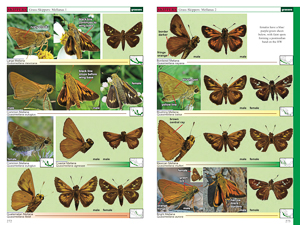 |
by Jeffrey Glassberg
Published by Princeton
Softback, 304 pages, ISBN 978-0-691-17648-2
From the publisher: "A fully revised second edition of the most detailed, comprehensive and user-friendly photographic field guide to the butterflies of Mexico and Central America, written by Jeffrey Glassberg, the pioneering authority on the field identification of butterflies".
The first edition of this book, published in 2007, was a game-changer for the identification of Mexican and Central American butterflies. Apart from De Vries's Butterflies of Costa Rica - an outstanding work but notably omitting the Lycaenidae and Hesperiidae - there was very little available for the general naturalist hoping to identify the butterflies of the region. If it was not something that strayed into the southern States or occurred in the West Indies, you either had to rely on d'Abrera's prohibitively expensive, seven-volume Butterflies of the Neotropical Region (which also omits the Hesperiidae) or try to track it down on the internet. Suddenly, here was a field guide, focused on identification, covering a substantial majority of the butterflies of Central America. This new edition retains all that was good about the first edition but with improved coverage and a large number of new pictures. It claims to include almost all species known to occur in Mexico and about 90% of those from Costa Rica and Panama. I imagine, therefore, that it will serve as an excellent guide to the butterflies of Guatemala and Nicaragua too.
 |
The focus is exclusively on identification. From page 8, after the briefest of introductions to Mexico, the book kicks in with the plates. These consist of small but well printed, annotated photos of each species, illustrating everything needed for confident identification. There is no text as such - rather, copious pointers to critical features. Similar species are grouped together so these notes make it easy to see what differentiates them. Most of the photos are of live individuals but there are also some set specimens, presumably where no good natural photos were available to illustrate particular features. The author has taken great care choosing the photos. The new edition not only contains more but has fresh pictures of species already illustrated in the first edition - sometimes even new pictures of the same individual, obviously taken in the same photo-shoot! No complacency there! The distribution of each species is indicated either with a small map, if it occurs in Mexico, or an indication of the countries it occurs in. Biological and ecological details are restricted to foodplant information. At the end of the book is a visual index showing 198 thumbnail photos, guiding the reader to the relevant plates. The main index is brief, limiting itself to generic groups in Latin and English rather than listing every species. Given that the book covers 2000 species, this is understandable - a complete index would consume valuable space. Nor is it a great inconvenience as the volume is very easy to navigate.
 |
The question, of course, is: does it work? Unfortunately, I could not take the book into the field in Mexico but I was able to put it through its paces on species found in my nearest butterfly house. My conclusion: yes it does. It was in fact very useful for Hamadryas species, pointing out exactly which features to look for. I also tried it out on the various Myscelia and Archeoprepona species flying there, where it was equally helpful in confirming identifications. Basically, it works - it is like having an expert on hand. I would love to have had a go at some skippers (the Neotropical region has more skippers than anywhere else in the world, and these occupy not far short of half the book) but for some reason these are never found in tropical butterfly houses. My impression, looking at the carefully annotated pictures, is that it would be outstanding for these too.
 |
If you are visiting Central America, this book is a must-buy. It is the only way you will have any hope of identifying the butterflies you will see. The fact it has no stories to tell about their lives, ecology and behaviour is not a shortcoming - it means the book is all the better at doing what it sets out to do. In the internet age, it is easy to find out more about a species when you know what it is, but well-nigh impossible to search for an obscure butterfly when you do not. Should you upgrade from the first edition if you already own that? The first edition remains excellent and the second is essentially the same book. Nevertheless, its coverage is significantly greater and I think it is worth upgrading if you are planning a trip to Central America.
The book is available through all good book stores, including those that are online.